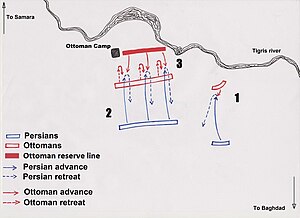
Back معركة سامراء (1733) Arabic Samarra döyüşü Azerbaijani سامرا دؤیوشو (۱۷۳۳) AZB Batalla de Samarra (1733) Spanish نبرد سامرا (۱۷۳۳) Persian Battaglia di Samarra (1733) Italian სამარას ბრძოლა Georgian Битва при Самарре (1733) Russian Ducum Muharebesi Turkish
| Battle of Samarra | |||||||||
|---|---|---|---|---|---|---|---|---|---|
| Part of the Ottoman–Persian War of 1730–35 | |||||||||
 1 Nader fails to gain an advantage on the Ottoman left due to Topal Pasha's hidden reinforcements which arrived secretly the night before 2 Nader, frustrated by this failure, forms up the core of his army and unleashes an overpowering onslaught on the main Ottoman line pushing the Turks back to very near their encampments 3 Topal Pasha brings forth his reserve line of 20,000 men and restores the situation by driving the Persians back. A brutally intense fight develops with the momentum of the battle swinging like a pendulum in both directions until the Persian army's morale collapses leaving the Ottomans as the clear yet bloodied victors. | |||||||||
| |||||||||
| Belligerents | |||||||||
|
|
| ||||||||
| Commanders and leaders | |||||||||
| Nader | Topal Osman Pasha | ||||||||
| Strength | |||||||||
|
70,000[2] |
80,000[4]
| ||||||||
| Casualties and losses | |||||||||
|
30,000[5] 3,000 captured 500 executed all the cannon & zamburaks | 20,000[6] | ||||||||
This article includes a list of references, related reading, or external links, but its sources remain unclear because it lacks inline citations. (March 2024) |
The Battle of Samarra was the key engagement between the two great generals Nader Shah and Topal Osman Pasha, which led to the siege of Baghdad being lifted, keeping Ottoman Iraq under Istanbul's control. The armed contest between the two colossi was very hard fought with a total of roughly 50,000 men becoming casualties by the end of the fighting that left the Persians decimated and the Ottoman victors badly shaken. Other than its importance in deciding the fate of Baghdad, the battle is also significant as Nader's only battlefield defeat although he would avenge this defeat at the hands of Topal Pasha at the Battle of Agh-Darband where Topal was killed.
- ^ Axworthy, Michael, "Iran: Empire of the Mind", Penguin Books, 2007. p156
- ^ Axworthy, Michael (2009). The Sword of Persia: Nader Shah, from tribal warrior to conquering tyrant,p. 180. I. B. Tauris
- ^ Moghtader, Gholam-Hussein(2008). The Great Batlles of Nader Shah,p. 56. Donyaye Ketab
- ^ Axworthy, Michael(2009). The Sword of Persia: Nader Shah, from tribal warrior to conquering tyrant,p. 180. I. B. Tauris
- ^ Axworthy, Michael(2009). The Sword of Persia: Nader Shah, from tribal warrior to conquering tyrant,p. 183. I. B. Tauris
- ^ Axworthy, Michael(2009). The Sword of Persia: Nader Shah, from tribal warrior to conquering tyrant,p. 183. I. B. Tauris
© MMXXIII Rich X Search. We shall prevail. All rights reserved. Rich X Search